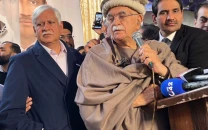‘Spiritual journey’: Sikh devotee discovers why Guru Nanak travelled to Pakistan
Amardeep Singh attempts to retrace interfaith coexistence through the footsteps of his religion's founder

A Sikh traveller has been on a journey to discover why Guru Nanak, the founder of the Sikh religion, had made the decision to travel to Pakistan and spend so many years of his life in the country.
Guru Nanak – the founder of Sikhism in the 15th and 16th centuries, travelled far and wide to spread his message of ‘Oneness of Creator’ and love for humanity.
In his spiritual journey of two decades, he visited hundreds of sites related to Hinduism, Islam, Buddhism, and Jainism.
These sites are now spread over across nine nations as per the current geographical divisions including Pakistan, India, Afghanistan, Iran, Saudi Arabia, Iraq, Tibet (China), Bangladesh and Sri Lanka.
After over 550 years, the footsteps of Guru Nanak have been retraced by Singapore-based researcher and author, Amardeep Singh, who has sequentially chronicled the saga into a 24-episode video documentary titled Allegory – A Tapestry of Guru Nanak’s Travels.
The docuseries takes viewers to the places and multi-faith sites that were visited by Guru Nanak during the 22 years of his life.
Born in India’s Gorakhpur to his migrated father belonging to Muzaffarabad and mother from Abbottabad, Amardeep Singh says his work is an ‘allegory’ of the spiritual journey of Guru Nanak who travelled with his philosophy of love and interfaith coexistence.
Also read: Indian Punjab's CM arrives in Kartarpur for Sikh pilgrimage
“Guru Nanak’s narrative of coexistence is to put humanity first and to not get divided by faith,” Amardeep Singh told APP, in a virtual interview from Singapore.
Leading a team, Amardeep travelled from Makkah and Madina to Mount Kailash, filmed amidst the gunfire in Afghanistan and the scalding summer heat in Iraq, across the waters of river Sindh on the boat, and the desert expanse of Madina to Baghdad.
In Pakistan, he travelled across the length and breadth of Sindh, Punjab, Khyber-Pukhtunkhwa, Balochistan, Azad Kashmir and Gilgit-Baltistan and visited the remnants of Sikh heritage, both tangible and non-tangible.
Amardeep mentioned that Guru Nanak twice went to the grave of Baba Farid in Pakpattan, Pakistan and held dialogues with Sheikh Baraham Farid Sani – the spiritual head of the 11th lineage.
“Baba Farid’s writings are included in the Sikh scriptures, which were first to be documented in [holy book] Guru Garanth. And we actually read it every day,” he said.
“In a world that is so fragile and volatile, there has never been a better time to understand why Guru Nanak travelled for 22 years to share his experiential wisdom and propagate the oneness of humankind,” Amardeep Singh said.
Asked about the opening of the Kartarpur Corridor by Pakistan in 2019 as an initiative to facilitate the Sikh pilgrims, he termed it a “very positive step”.
“This [Kartarpur Corridor] is a ray of hope for the people of sub-continent that has sown the love for coming generations,” he said, adding that multiple such arteries needed to be opened up through culture and faith to build trust across the boundaries.
Also read: Opening of Kartarpur Corridor good development: FM Qureshi
Prime Minister Imran Khan has taken several initiatives to facilitate Sikh pilgrims, including the historic opening of the visa-free Kartarpur Sahib Corridor in November 2019 on the occasion of the 550th birth anniversary of Guru Nanak. The Gurdwara Kartarpur Sahib complex is a gift by the people of Pakistan and their leadership to the Sikh community from India and worldwide.
In line with his vision of emulating the concept of Islam’s first socio-welfare State of Madina, Premier Imran on several occasions has said that his government firmly believes that no society can achieve the goal of inclusive socio-economic development without ensuring the rights of minorities.
This November, Pakistan issued 3,000 visas to Indian Sikh pilgrims to enable them to participate in the 552nd birth anniversary celebrations of Guru Nanak on November 17-26. The Sikh pilgrims during their stay in Pakistan will visit different Gurdwaras, including Gurdwara Janam Asthan in Nankana Sahib and Gurdwara Darbar Sahib in Kartarpur.
Amardeep Singh quoted the message of Guru Nanak in Punjabi as saying ‘Eiko dharam dhrirey sach koi’, meaning ‘Truth is the only righteousness as a universal law’.
“It is important to understand that Guru Nanak was an embodiment of Oneness,” said Singh, who has also titled the first episode of his documentary “Noor-e-Tawheed” (Light of Oneness).
The docuseries, completed in three-and-a-half years, is available at the website ‘TheGuruNanak.com’, of which Amardeep Singh says, “This is not just about Guru Nanak’s philosophy on Sikhism, but humanity”.
‘Allegory’: Retracing interfaith coexistence through #GuruNanak’s footsteps#KartarpurCorridor is a ray of hope for the people of sub-continent that has sown the love for coming generations#GuruNanakJayanti #APPNews @fawadchaudhry https://t.co/lYuh531kv3 via @appcsocialmedia
— APP 🇵🇰 (@appcsocialmedia) November 18, 2021


















COMMENTS
Comments are moderated and generally will be posted if they are on-topic and not abusive.
For more information, please see our Comments FAQ